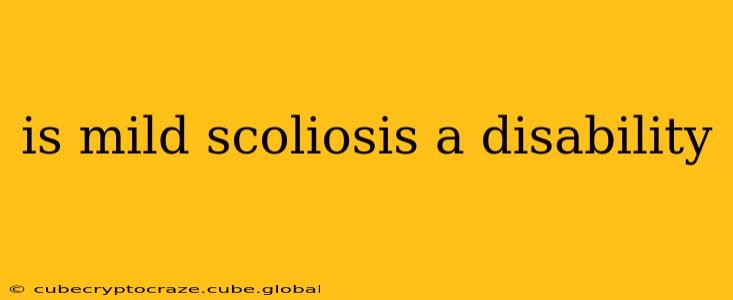Scoliosis, a sideways curvature of the spine, affects millions worldwide. While severe scoliosis undeniably presents significant challenges, the question of whether mild scoliosis qualifies as a disability is far more nuanced. The answer depends on several factors, including the severity of the curvature, its impact on daily life, and individual circumstances. This article delves into the complexities of mild scoliosis and its potential impact on an individual's ability to function.
What is Considered Mild Scoliosis?
Mild scoliosis is generally defined as a Cobb angle of less than 25 degrees. The Cobb angle is a measurement used by doctors to quantify the degree of spinal curvature on an X-ray. Curvatures under 25 degrees are often considered mild and may not require any treatment beyond regular monitoring. However, even a mild curvature can cause symptoms in some individuals, while others experience no noticeable effects.
Does Mild Scoliosis Qualify for Disability Benefits?
This is a crucial question with no simple answer. Disability benefits programs, such as Social Security Disability Insurance (SSDI) in the US, have specific criteria for determining eligibility. These criteria often focus on whether the condition significantly limits a person's ability to engage in substantial gainful activity (SGA). Mild scoliosis rarely meets this stringent standard on its own.
The key factor is the impact of the scoliosis on an individual's life. If mild scoliosis causes significant pain, fatigue, or limitations in mobility that prevent someone from working or performing daily activities, it might contribute to a disability claim, especially when considered alongside other health conditions. However, it's highly unlikely that mild scoliosis alone would be sufficient grounds for disability benefits.
Can Mild Scoliosis Affect Daily Activities?
While many individuals with mild scoliosis experience no significant limitations, some may encounter challenges. These might include:
- Back Pain: Even a small curvature can lead to muscle imbalances and pain, particularly with prolonged standing or physical activity.
- Fatigue: The body may work harder to compensate for the spinal curvature, leading to increased fatigue.
- Postural Issues: Mild scoliosis can affect posture, potentially leading to discomfort or aesthetic concerns.
- Respiratory Issues: In rare cases, severe curvatures can impact lung capacity. While less common in mild scoliosis, it's still a possibility to consider.
What are the Treatment Options for Mild Scoliosis?
Treatment for mild scoliosis usually focuses on monitoring and conservative management. This may include:
- Regular check-ups: To monitor the progression of the curvature.
- Physical therapy: To strengthen core muscles and improve posture.
- Bracing: In some cases, a brace might be recommended to prevent progression, though this is less common with mild curvatures.
How is Mild Scoliosis Diagnosed?
Diagnosis typically involves a physical examination and X-rays. The X-rays allow doctors to measure the Cobb angle and assess the severity of the curvature. Early diagnosis is essential for monitoring and managing the condition effectively.
Does Mild Scoliosis Affect Athletic Performance?
The impact of mild scoliosis on athletic performance varies considerably depending on the individual, the sport, and the severity of the curvature. In many cases, mild scoliosis poses minimal limitations. However, in some instances, it might lead to muscle imbalances that affect performance or increase the risk of injury.
Conclusion:
Whether mild scoliosis constitutes a disability is highly dependent on the individual's specific circumstances and the impact it has on their daily life. While the curvature itself may not be disabling, its associated symptoms or combined effects with other health conditions can significantly limit functional capabilities. It's crucial to consult with medical professionals and disability specialists for personalized assessments and guidance. Early diagnosis and proactive management are key to minimizing the potential impact of mild scoliosis.
